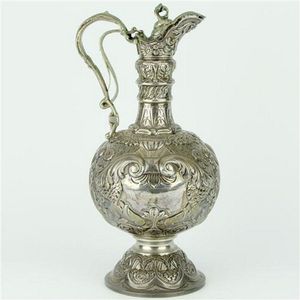Victorian Sterling Silver Armada Jug
You must be a subscriber, and be logged in to view price and dealer details.
Subscribe Now to view actual auction price for this item
When you subscribe, you have the option of setting the currency in which to display prices to $Au, $US, $NZ or Stg.
- Victorian Period - The Victorian period of furniture and decorative arts design covers the reign of Queen Victoria from 1837 to 1901. There was not one dominant style of furniture in the Victorian period. Designers used and modified many historical styles such as Gothic, Tudor, Elizabethan, English Rococo, Neoclassical and others, although use of some styles, such as English Rococo and Gothic tended to dominate the furniture manufacture of the period.
The Victorian period was preceded by the Regency and William IV periods, and followed by the Edwardian period, named for Edward VII (1841 ? 1910) who was King of the United Kingdom and the British Dominions and Emperor of India for the brief period from 1901 until his death in 1910. - Sterling Silver - Sterling silver is a mixture of 92.5% pure silver and 7.5% of another metal, usually copper. Fine silver is 99.9% pure silver, and is relatively soft and the addition of the very small amount of copper gives the metal enough strength and hardness to be worked into jewellery, decorative and household objects.
- Foliate - Decorated with leaves or leaf-like forms.
- Chasing - The method of decorating gold and silver objects using a punch and hammer so that the design appears in relief. Flat or surface chasing is done from the front giving the item definition, but not cutting into the metal.
Chasing is the opposite technique to repousse, but an object that has repousse work, may then have chasing applied to create a finished piece. - Armorial / Armourial - Bearing a coat of arms. Coats of arms came into general use by feudal lords and knights in in the 12th century, and by the 13th century, arms had spread beyond their initial battlefield use to become a flag or emblem for families in the higher social classes of Europe. They were inherited from one generation to the next. When a family crest is used on individual items of silver or furniture it is an indicator of the aristocratic standing of the family represented.
Armorials were also used to decorate mass produced ceramic souvenir ware by such companies as Goss, Carlton & Shelley, and in these cases the coats of arms displayed were of boroughs and cities. - Cartouche - An ornamental panel in the form of of a shield, oval or rectangular scroll with curling edges. It may be carved into the back of a chair or the top of a sideboard, or present on a piece of silver or jewellery, and contain the initials of the original owner, heraldic symbols, or some other inscription, such as the details of a presentation.
In ceramics the term defines the central area of a vase or similar with a decorative border in one of the shapes above, into which a decorative scene or figures have been painted.
This item has been included into following indexes:
Visually similar items

Spanish silver 915 standard ewer having a pull spring handled mechanism, with two satyr heads to one side of the body & two vacant cartouches to the other, with all over scrolled & floral raised detail.

A Victorian sterling silver bulbous floral embossed water jug by Harry Wilson, London 1860, 34 cm high, 805 grams

A Victorian silver claret jug well modelled with winged mythological figures, lions head, foliate swags and scrolls surrounding vacant cartouches, ivory filets and gilt interior, Martin, Hall & Co. Ltd., London 1880. Height 37 cm. Weight 1312gms

A William IV silver wine jug, Barnard Brothers, London 1831, the baluster body with a band of stiff leaves, grape and vine rim, loop handle, hinged cover with pomegranate finial, 29 cm high, 1020 gms
